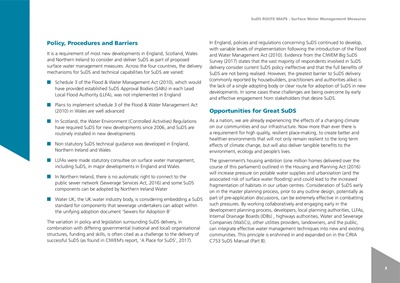
SuDS ROUTE MAPS - Surface Water Management Measures
3
Policy, Procedures and Barriers
It is a requirement of most new developments in England, Scotland, Wales
and Northern Ireland to consider and deliver SuDS as part of proposed
surface water management measures. Across the four countries, the delivery
mechanisms for SuDS and technical capabilities for SuDS are varied:
Schedule 3 of the Flood & Water Management Act (2010), which would
have provided established SuDS Approval Bodies (SABs) in each Lead
Local Flood Authority (LLFA), was not implemented in England
Plans to implement schedule 3 of the Flood & Water Management Act
(2010) in Wales are well advanced
In Scotland, the Water Environment (Controlled Activities) Regulations
have required SuDS for new developments since 2006, and SuDS are
routinely installed in new developments
Non statutory SuDS technical guidance was developed in England,
Northern Ireland and Wales
LLFAs were made statutory consultee on surface water management,
including SuDS, in major developments in England and Wales
In Northern Ireland, there is no automatic right to connect to the
public sewer network (Sewerage Services Act, 2016) and some SuDS
components can be adopted by Northern Ireland Water
Water UK, the UK water industry body, is considering embedding a SuDS
standard for components that sewerage undertakers can adopt within
the unifying adoption document 'Sewers for Adoption 8'
The variation in policy and legislation surrounding SuDS delivery, in
combination with differing governmental (national and local) organisational
structures, funding and skills, is often cited as a challenge to the delivery of
successful SuDS (as found in CIWEM's report, 'A Place for SuDS', 2017).
In England, policies and regulations concerning SuDS continued to develop,
with variable levels of implementation following the introduction of the Flood
and Water Management Act (2010). Evidence from the CIWEM Big SuDS
Survey (2017) states that the vast majority of respondents involved in SuDS
delivery consider current SuDS policy ineffective and that the full benefits of
SuDS are not being realised. However, the greatest barrier to SuDS delivery
(commonly reported by housebuilders, practitioners and authorities alike) is
the lack of a single adopting body or clear route for adoption of SuDS in new
developments. In some cases these challenges are being overcome by early
and effective engagement from stakeholders that desire SuDS.
Opportunities for Great SuDS
As a nation, we are already experiencing the effects of a changing climate
on our communities and our infrastructure. Now more than ever there is
a requirement for high quality, resilient place-making, to create better and
healthier environments that will not only remain resilient to the long term
effects of climate change, but will also deliver tangible benefits to the
environment, ecology and people's lives.
The government's housing ambition (one million homes delivered over the
course of this parliament) outlined in the Housing and Planning Act (2016)
will increase pressure on potable water supplies and urbanisation (and the
associated risk of surface water flooding) and could lead to the increased
fragmentation of habitats in our urban centres. Consideration of SuDS early
on in the master planning process, prior to any outline design, potentially as
part of pre-application discussions, can be extremely effective in combatting
such pressures. By working collaboratively and engaging early in the
development planning process, developers, local planning authorities, LLFAs,
Internal Drainage Boards (IDBs) , highways authorities, Water and Sewerage
Companies (WaSCs), other utilities providers, landowners, and the public,
can integrate effective water management techniques into new and existing
communities. This principle is enshrined in and expanded on in the CIRIA
C753 SuDS Manual (Part B).